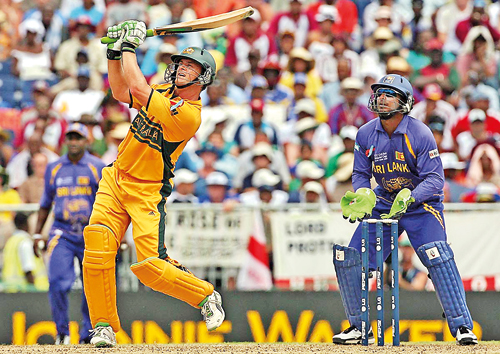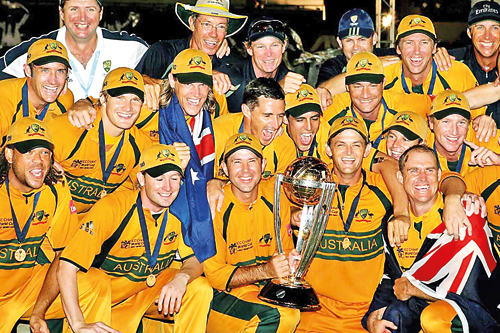Whatever happened to Adam Gilchrist’s half Squash ball?
View(s): The 9th Cricket World Cup (WC) was staged in the West Indies (WI) from March13-April 28, 2007, with 16 teams divided into 4 Groups. The 2 top teams in each Group moving into a Super 8 format. Australia’s 29 unbeaten wins in the WC, dating back to May 23, 1999, showed their dominance in this format of the game.
The 9th Cricket World Cup (WC) was staged in the West Indies (WI) from March13-April 28, 2007, with 16 teams divided into 4 Groups. The 2 top teams in each Group moving into a Super 8 format. Australia’s 29 unbeaten wins in the WC, dating back to May 23, 1999, showed their dominance in this format of the game.Sri Lanka (SL) had the batting strengths of skipper Jayawardena, Sangakkara, Jayasuriya, Atapattu, Dilshan et al, with the combined bowling strengths of Murali, Vaas, Maharoof & Co.
Though India and Pakistan were considered favourites for the title, both sides fell early. India lost to Bangladesh and SL, while Pakistan lost to the WI, and surprisingly to Ireland by 3wickets.
Eventually, the 4 semifinalists emerged- New Zealand (NZ), SL, South Africa (SA) and Australia- for the 2007 title.
In the 1st semifinal, played at Sabina Park, SL rattled up 289/5, against NZ, Mahela top-scored with 115 in 109 balls. In reply, NZ were dismissed tamely for 208 in 41.4 overs, with the ubiquitous Muralidaran capturing 4/31. SL thus entered the final with a win by 81 runs.
In the 2nd semifinal, between SA and Australia, played at St. Lucia, the former was bundled out for 149 runs, Australian paceman, Shaun Tait (4/39) being the chief wrecker. Australia coasted to a facile win by scoring 153/3 (in 31.3 overs). Michael Clarke top-scored with an unbeaten 60 runs.
So now the same finalists, as in 1996, emerged- SL and Australia.
Australia scored 281/4 (Gilchrist 149 in 104 balls) and SL’s reply, based on the DL method, was 215/8 in 36 overs, conceding a 53-run win to Australia, who became WC champions for the 3rd successive time and for the 4th occasion in all. This was SL’s second WC appearance in the final and Australia’s 6th.
Now for the inside stories. Were there wheels within wheels?
 At the end of the 33rd over, with SL still trailing, the umpires suspended the game due to bad light. There was more confusion that followed.
At the end of the 33rd over, with SL still trailing, the umpires suspended the game due to bad light. There was more confusion that followed.
As Andrew Miller reporting from Barbados, stated: “While Australia’s players began to celebrate their victory, the Umpires incorrectly announced that because the match was suspended due to bad light and not rain, the final 3 overs would have to be bowled the following day. With SL needing 61 runs from 18 deliveries, Jayawardene agreed there was no need to return the following day, and instructed his team to resume batting, with Ricky Ponting agreeing to bowl only spinners.” The Umpires later apologized for their error.
Let’s now study the explosive innings by Gilchrist who tonked 13 fours and 8 sixes, in making a match-winning innings of 149 runs …… Was it coincidence that Gilchrist, until the final, aggregated only 304 runs, a third of which comprised half-centuries against the lowly placed Bangladesh and Netherlands? In the final, however, he suddenly metamorphosed to thump 149 runs in 104 balls, including 100 runs in boundaries. All the while, 5 of his teammates, a quintet of outstanding stroke-makers (Hayden, Ponting, Symonds, Watson and Clarke) contributed a mere 7 fours and 2 sixes!
Was it not because Gilchrist had the added advantage of a part of a squash ball inside the glove in his left-hand? As his mentor Bob Meuleman commented: “He (Gilchrist) had a few hits before he went off to the WC and he didn’t have the squash ball in, and he hit them like he couldn’t even play fourth grade. He put it (the squash ball) in and he then hit the ball so good…….”

Australia won their third successive World Cup in 2007
Here’s a scientific explanation by an expert on this issue:
“A squash ball is a rubber ball, it compresses when pressure is applied on it. When the pressure is released it takes the original shape. In short, it acts like a spring ……So what happens when a batsman secretes a squash ball inside the glove of his bottom hand? When a batsman swings the bat until it hits the ball….this pressure compresses the squash ball similar to a spring. At the same time the energy stored in the squash ball releases its energy in the form of kinetic energy as a result, the release speed of the cricket ball becomes faster resulting in the ball traveling further……in brief, Gilchrist’s use of the squash ball allowed him to send the ball further in the field.”
Now, here’s what the Laws of Cricket has to say regarding the use of implements by a player.
Law 3 (Umpires), sub-section 6: ‘conduct of the game, implements and equipment’:
“Before the toss and during the match, the umpires shall satisfy themselves that
(a) conduct of the game is strictly in accordance with the Laws.
(b) implements of the game conform to the requirements of Laws 5 (The Ball) and 6 (The Bat), together with either laws 8.2 (size of Stumps) and 8.3 (The Bails) or, if appropriate, law 8.4 (Junior Cricket).
(c) (i) no player uses equipment other than that permitted …………
So, it is crystal clear, that the Laws of Cricket, as above, does not permit the use of a squash ball or even a part thereof. Or for that matter, a slip fielder would not be permitted to use springs secreted inside his boots to jump higher!
Interestingly, the likes of Gilchrist & Co. have realized this ‘SECRETIVE’ issue. If this ruse of having a part of a squash ball helped to thump the ball ever so easily, why was this ploy not repeated but simply pushed under the carpet?


